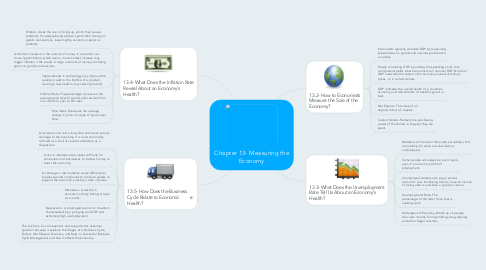Chapter 13- Measuring the Economy
by MICHAEL MATTSON

1. 13.2- How to Economists Measure the Size of the Economy?
1.1. Economists typically calculate GDP by measuring expenditures on goods and services produced in a country.
1.2. Simply calculating GDP by adding the spending on its four components yields what economists call nominal GDP. Nominal GDP measures the output of an economy valued at today’s prices, or in current dollars.
1.3. GDP indicates the overall health of a countries economy and tells whether its health is good or bad.
1.4. Net Exports- The value of all exports minus all imports.
1.5. Current Dollars- Reflects the purchasing power of the dollars in the year they are spent.
2. 13.3- What Does the Unemployment Rate Tell Us About an Economy’s Health?
2.1. Members of the labor force who are jobless, but are looking for work, are classified as unemployed.
2.2. Some people will always be out of work, even in an economy with full employment.
2.3. Unemployed workers also pay a serious economic cost. Not being able to have an income or being able to purchase a good or service.
2.4. Unemployment Rate- The percentage of the labor force that is seeking work.
2.5. Underground Economy- Made up of people who earn income from gambling, drug dealing, and other illegal activities.
3. 13.4- What Does the Inflation Rate Reveal About an Economy’s Health?
3.1. Inflation drives the cost of living up, which then causes problems for people being able to spend their money on goods and services, lowering the economic spend on products.
3.2. A dramatic increase in the amount of money in circulation can cause hyperinflation, which even a more modest increase may trigger inflation if the results in large amounts of money not being spent on goods and services.
3.3. Improvements in technology may improve the quality or add to the lifetime of a product, causing a less need to buy certain products.
3.4. Inflation Rate- The percentage increase in the average price level of goods and services from one month or year to the next.
3.5. Price Index- Measures the average change in price of a type of good over time.
4. 13.5- How Does the Business Cycle Relate to Economic Health?
4.1. A recession can last a long time and cause serious damage to the economy. It is most commonly referred as a kind of severe contraction as a depression.
4.2. A rise in interests rates causes difficulty for consumers and businesses to borrow money to boost the economy.
4.3. A shortage in raw materials cause difficulty for businesses and companies to produce goods to support the economy, causing a raise in prices.
4.4. Recession- A decline in economic activity lasting at least six months.
4.5. Depression- A prolonged economic downturn characterized by a plunging real GDP and extremely high unemployment.
4.6. The link from Inc.com explains and supports this essential question because it explains the Stages of a Business Cycle, Factors that Shape a Business, and Keys to Successful Business Cycle Management and how it effects the economy.


